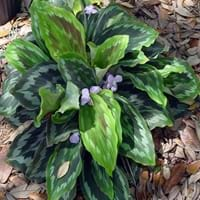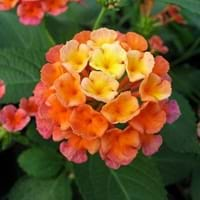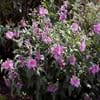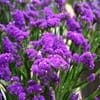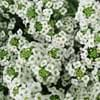Life Span
Annual
Annual and Perennial
Type
Tender Perennial
Tender Perennial
Origin
Southeastern Asia
Mexico, Central America, South America, Africa, Polynesia, Australia
Types
Not Available
Not Available
Habitat
Shady Edge
Tropical regions
USDA Hardiness Zone
8-12
8-11
Sunset Zone
H1, H2, 21, 22, 23, 24
A1, A2, A3, H1, H2, 1a, 1b, 2a, 2b, 3a, 3b, 4, 5, 6, 7, 8, 9, 10, 11, 12, 13, 14, 15, 16, 17, 18, 19, 20, 21, 22, 23, 24
Habit
Clump-Forming
Oval or Rounded
Flower Color
Purple, Lavender
Multicolor
Flower Color Modifier
Bicolor
Bicolor
Fruit Color
Not Available
Indigo
Leaf Color in Spring
Green, Light Green
Green, Dark Green
Leaf Color in Summer
Green, Dark Green
Green, Dark Green
Leaf Color in Fall
Green, Dark Green
Green, Dark Green
Leaf Color in Winter
Light Green
Light Green
Leaf Shape
Arrowhead
Obtuse
Plant Season
Spring, Summer, Fall
Spring, Summer, Fall, Winter
Sunlight
Partial shade
Full Sun, Partial Sun
Type of Soil
Loam, Sand
Loam, Sand
The pH of Soil
Acidic, Neutral
Acidic, Neutral
Soil Drainage
Well drained
Well drained
Bloom Time
Early Summer, Summer, Late Summer, Early Fall
Indeterminate
Tolerances
Drought
Drought
Where to Plant?
Ground
Container, Ground, Pot
How to Plant?
Divison, Tubers
Seedlings
Plant Maintenance
Medium
Medium
Watering Requirements
Requires regular watering
Average Water Needs
In Summer
Lots of watering
Lots of watering
In Spring
Moderate
Moderate
In Winter
Average Water
Average Water
Soil pH
Acidic, Neutral
Acidic, Neutral
Soil Type
Loam, Sand
Loam, Sand
Soil Drainage Capacity
Well drained
Well drained
Sun Exposure
Partial shade
Full Sun, Partial Sun
Pruning
Remove damaged leaves, Remove dead branches, Remove dead leaves
Remove damaged leaves, Remove dead branches, Remove dead leaves
Fertilizers
All-Purpose Liquid Fertilizer
All-Purpose Liquid Fertilizer
Pests and Diseases
Red blotch
Grasshoppers, Moth
Plant Tolerance
Drought
Drought
Flower Petal Number
Single
Single
Foliage Texture
Medium
Medium
Foliage Sheen
Matte
Matte
Attracts
Not Available
Butterflies, Hummingbirds
Allergy
Not Available
Toxic
Aesthetic Uses
Ground Cover
Showy Purposes
Beauty Benefits
Not Available
Not Available
Environmental Uses
Air purification
Air purification
Medicinal Uses
Carminative, Diuretic, Exoectorant, Pectoral, Stimulates new cell growth, Throat infection
Antifungal, antimicrobial
Part of Plant Used
Flowers, Leaves
Leaves, stalk
Other Uses
Oil is used in perfume, soaps, creams, etc.
Making chairs to parquetry (flooring) and staircases
Used As Indoor Plant
Yes
Yes
Used As Outdoor Plant
Yes
Yes
Garden Design
Container, Groundcover, Tropical
Bedding Plant, Container, Feature Plant, Foundation, Mixed Border, Tropical
Botanical Name
KAEMPFERIA elegans
Lantana camara
Common Name
Peacock Ginger
Lantana
In Hindi
Peacock Ginger
Lantana
In German
Pfau Ingwer
Lantana
In French
paon gingembre
Lantana
In Spanish
jengibre pavo real
Lantana
In Greek
παγώνι τζίντζερ
Lantana
In Portuguese
gengibre pavão
Lantana
In Polish
paw imbiru
Lantana
In Latin
gingiberi pavo
Lantana
Phylum
Magnoliophyta
Magnoliophyta
Class
Liliopsida
Magnoliopsida
Order
Zingiberales
Lamiales
Family
Zingiberaceae
Verbenaceae
Clade
Angiosperms, Commelinids, Monocots
Angiosperms, Asterids, Eudicots
Tribe
Not Available
Not Available
Subfamily
Not Available
Not Available
Difference Between Peacock Ginger and Lantana
If you are confused whether Peacock Ginger or Lantana are same, here are some features about those plants to help you choose better. Many people think that these two plants have the same characteristics, but one can see Peacock Ginger and Lantana Information and learn more about it. Fertilizers required for proper growth of Peacock Ginger are All-Purpose Liquid Fertilizer, whereas for Lantana fertilizers required are All-Purpose Liquid Fertilizer. Hence, one should know the basic difference between Peacock Ginger and Lantana if you are planning to have them in your garden to enhance its beauty.
<
Flowering PlantsImportance of Peacock Ginger and Lantana
Want to have the most appropriate plant for your garden? You might want to know the importance of Peacock Ginger and Lantana. Basically, these two plants vary in many aspects. Compare Peacock Ginger and Lantana as they differ in many characteristics such as their life, care, benefits, facts, etc. Every gardener must at least have the slightest clue about the plants he wants to plant in his garden. Compare their benefits, which differ in many ways like facts and uses. The medicinal use of Peacock Ginger is Carminative, Diuretic, Exoectorant, Pectoral, Stimulates new cell growth and Throat infection whereas of Lantana is Antifungal and antimicrobial. Peacock Ginger has beauty benefits as follows: Not Available while Lantana has beauty benefits as follows: Not Available.
Compare Facts of Peacock Ginger vs Lantana
How to choose the best garden plant for your garden depending upon its facts? Here garden plant comparison will help you to solve this query. Compare the facts of Peacock Ginger vs Lantana and know which one to choose. As garden plants have benefits and other uses, allergy is also a major drawback of plants for some people. Allergic reactions of Peacock Ginger are Not Available whereas of Lantana have Toxic respectively. Having a fruit bearing plant in your garden can be a plus point of your garden. Peacock Ginger has no showy fruits and Lantana has showy fruits. Also Peacock Ginger is not flowering and Lantana is not flowering . You can compare Peacock Ginger and Lantana facts and facts of other plants too.
